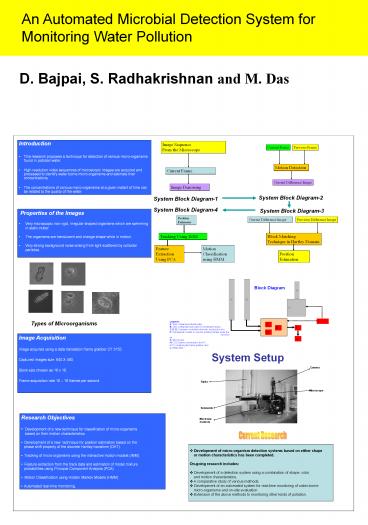Microelectronics - PowerPoint PPT Presentation
1 / 1
Title:
Microelectronics
Description:
An Automated Microbial Detection System for Monitoring Water Pollution D. Bajpai, S. Radhakrishnan and M. Das Introduction This research proposes a technique for ... – PowerPoint PPT presentation
Number of Views:53
Avg rating:3.0/5.0
Title: Microelectronics
1
An Automated Microbial Detection System for
Monitoring Water Pollution
D. Bajpai, S. Radhakrishnan and M. Das
- Introduction
- This research proposes a technique for detection
of various micro-organisms found in polluted
water. - High resolution video sequences of microscopic
images are acquired and processed to identify
water borne micro-organisms and estimate their
concentrations. - The concentrations of various micro-organisms at
a given instant of time can be related to the
quality of the water.
Image Sequence From the Microscope
Previous Frame
Current Frame
Motion Detection
Current Frame
Current Difference Image
Image Denoising
System Block Diagram-2
System Block Diagram-1
System Block Diagram-4
System Block Diagram-3
- Properties of the Images
- Very microscopic non-rigid, irregular shaped
organisms which are swimming in static clutter. - The organisms are translucent and change shape
while in motion. - Very strong background noise arising from light
scattered by colloidal particles.
Position Estimates
Previous Difference Image
Current Difference Image
Block Matching Technique in Hartley Domain
Tracking Using IMM
Feature Extraction Using PCA
Motion Classification using HMM
Position Estimation
A
B
H
Block Diagram
G
I
Types of Microorganisms
Legends A Tank containing polluted water. B
Tank containing clean water for flushing the
tubes. C, D, E Computer controlled solenoids,
and junction box F Transparent Cuvette to view
the polluted sample under the microscope. G
Microscope. H CCD camera connected to the PC. I
PC containing the frame grabber card. J Waste
tank.
C
E
F
D
Image Acquisition Image acquired using a data
translation frame grabber DT 3155. Captured
images size 640 X 480. Block size chosen as 16
x 16. Frame acquisition rate 10 16 frames per
second.
J
System Setup
Camera
Tanks
Microscope
Solenoids
- Research Objectives
- Development of a new technique for
classification of micro-organisms - based on their motion characteristics.
- Development of a new technique for position
estimation based on the - phase shift property of the discrete Hartley
transform (DHT). - Tracking of micro-organisms using the
interactive motion models (IMM). - Feature extraction from the track data and
estimation of model mixture - probabilities using Principal Component
Analysis (PCA). - Motion Classification using Hidden Markov
Models (HMM). - Automated real-time monitoring.
Electronic Controls
Current Research
- Development of micro-organism detection systems
based on either shape - or motion characteristics has been completed.
- On-going research includes
- Development of a detection system using a
combination of shape, color - and motion characteristics.
- A comparative study of various methods.
- Development of an automated system for real-time
monitoring of water-borne - micro-organisms and on-site evaluation.
- Extension of the above methods to monitoring
other kinds of pollution.































